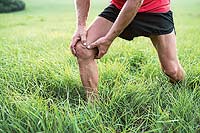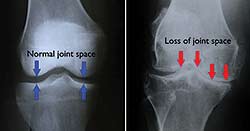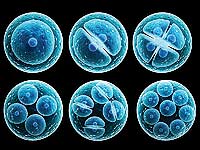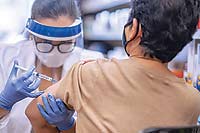In medical school, we were taught that osteoarthritis comes from wear and tear; overuse of a joint. From a mechanical standpoint, we all recognize that things with moving parts wear out, sooner or later. But this explanation left me with more questions than answers.
Unlike machines, the human body was designed with a remarkable ability to heal itself. Every day, we are healing cuts and bruises, replacing dead skin, making new blood cells, regenerating our liver, and so on. Why should joints be any different?
We are far less physically active than our pioneer forefathers, who never needed to drive to the gym to get exercise. Yet we have an epidemic of arthritis—over 32.5 million adults in America. Even men in their twenties are being diagnosed with it.
What else doesn't make sense is the fact that one joint can be arthritic while the same joint on the other side of the body is not, even though both experience similar wear and tear. And how do we explain arthritis in multiple joints in different parts of the body?
The answer to all of these mysteries lies in the name "arthritis" itself: "-itis" indicates that this is an inflammatory condition, not merely a consequence of overworking a joint, even if repetitive activities do in fact contribute to the problem.
 In the decades since I graduated from medical school, research has revealed that arthritic joints have both low-grade infections and insulin resistance. Both of these are highly inflammatory. Historically, doctors have treated inflammation with anti-inflammatory medications, such as Ibuprofen, Naprosyn, Celebrex, and the like. But these and other drugs only relieve symptoms for hours at a time. Once the pain gets bad enough, doctors inject more potent anti-inflammatories called corticosteroids directly into affected joints, yielding seemingly miraculous results, at least for a few months. Published studies have been unable to prove any long-term benefit. In the decades since I graduated from medical school, research has revealed that arthritic joints have both low-grade infections and insulin resistance. Both of these are highly inflammatory. Historically, doctors have treated inflammation with anti-inflammatory medications, such as Ibuprofen, Naprosyn, Celebrex, and the like. But these and other drugs only relieve symptoms for hours at a time. Once the pain gets bad enough, doctors inject more potent anti-inflammatories called corticosteroids directly into affected joints, yielding seemingly miraculous results, at least for a few months. Published studies have been unable to prove any long-term benefit.
While both of these approaches provide pain relief, neither has any effect on the underlying causes of arthritis or on the course of the disease. More concerning, all anti-inflammatory drugs increase your risk of heart attack, stroke, bleeding ulcers, kidney damage, high blood pressure, and more. One review reported that 30% of all drug-event-related hospitalizations are due to NSAIDs. And steroid injections are not without risk, either. If you have diabetes, one of these injections can raise your blood sugar for a period of months. Moreover, whereas we used to think there was no limit to the number of injections a joint could handle, recent studies have demonstrated that steroids actually increase damage to cartilage, leading to sooner joint replacement.
There is definitely a place for surgery, whether it's a scope or a joint replacement. But why not see if you can put it off 10, 20, or 30 years? Artificial joints have a limited lifespan and have to be replaced eventually. Surgery itself brings unavoidable risks, expense, downtime, recovery, and physical therapy. For these reasons, experienced orthopedic surgeons wisely delay these procedures as long as possible.
But what can you do in the meantime to avoid needless suffering? At Prestige Wellness Institute, people achieve improved joint health using both a local and a systemic approach. You can undergo treatment with infection-fighting, nourishing, and regenerating therapies to heal the joint from the inside out. These include ozone, platelet rich plasma, stem cells, peptides, exosomes, and/or pulsed electromagnetic field therapy. At the same time, you benefit from a global approach to reducing insulin resistance and inflammation, providing a nourishing environment for healing to that joint, as well as the rest of them.
Whereas your immediate concern may be the pain that keeps you from hiking, golfing, traveling, skiing, gardening, or playing with the grandkids, there is much more at risk than comfort and activity. Recent studies have demonstrated a 31% higher risk of heart attack in people with osteoarthritis. The risk is even higher for rheumatoid arthritis, gout, and other types of arthritis.
At Prestige Wellness Institute, you can combine the benefits of regenerative medicine with functional medicine to address the underlying causes of your pain while reducing your risks of more serious degenerative diseases, such as heart disease. Join many others who lead active lives again without pain, even after being told their joints are "bone-on-bone." Schedule an appointment to see if you qualify for our program. It's not just a painful joint that's at stake. It could be your life.
(These statements have not been evaluated by any agency of the U.S. Government. Nothing stated herein constitutes medical advice or is designed to replace consultation with your physician. All statements are based on published medical studies and experience. No product or procedure mentioned above is designed to diagnose, treat, prevent, or cure any disease).
|
When I was pregnant with my son, my mother began sending me books on vaccine safety—or rather her belief in the lack thereof and the importance of not following the Centers for Disease Control’s regular vaccine schedule.
 I’ll be honest, her feelings freaked me out even though I’m a physician assistant with a master’s degree in public health. When I analyzed the resources my mother had shared with me, it was clear that the claims were based on anecdotes and poor data. None of the sources had evidence to support their claims of serious consequences. I’ll be honest, her feelings freaked me out even though I’m a physician assistant with a master’s degree in public health. When I analyzed the resources my mother had shared with me, it was clear that the claims were based on anecdotes and poor data. None of the sources had evidence to support their claims of serious consequences.
Unfortunately, it shook the emotional side of my brain up. I skipped or delayed some recommended vaccines for my newborn son. At 6-months-old, my son developed breath-holding spells that provoked mild convulsions. He had a few full-blown seizures and information from my mother began pouring in. She blamed the vaccines we’d given my son for his condition.
My heart was tortured by the idea I had perhaps done something to harm my child. I had a consultation with a pediatric neurologist at the University of Utah after my son’s first seizure. Near tears, I asked her if this could at all be related to something I had done. The surprise and then pity on her face was clear. She assured me that evidence shows that vaccines are safe and have no connection to my son’s breath holding spells. I had done the research, I asked experts, and I had an excellent education to make an informed choice about vaccine safety.
My son was about one year old when I discovered a book called “On Immunity: An Inoculation,” written by Eula Biss. The book discusses the history of childhood vaccination and where a small group of individuals showed fear surrounding this practice. The author creates an eloquent argument about how choosing to vaccinate ourselves and our children is a public service and ultimately, an act of love. This sentiment resonated deeply with me after my experience.
Over the past years, that idea of choosing love over fear has really motivated me to do what I know is right. Getting my second child vaccinated on schedule was much easier to do without all the fear. I now have discussions with my children about how the protection they create is not just for themselves, but for the childhood cancer survivor in early remission, or for elders with waning immune systems, or for the immuno-compromised individuals who are unable to receive vaccines.
Biss speaks to the simple truth: “We are each other’s environment. Immunity is a shared space — a garden we tend together.”
In my research about the COVID-19 vaccine, I saw no shortcuts taken with safety research during the development of this vaccine. Health researchers have known for decades that a novel virus would cause a pandemic at some point and so have spent many decades studying the spike protein on coronaviruses, which is the target methodology of both the Moderna and the Pfizer vaccines.
It’s true the coronavirus vaccine was developed in record time, but not at the expense of rushing clinical trials. The speedy development was due to a concerted effort of our government and private industry working with public health researchers. The safety steps with clinical trials were not skipped. Rather, the steps that tend to happen in a serial fashion happened at the same time to expedite the process. It wasn’t safety that was sacrificed, it was the red tape of bureaucracy that was cut. This is the fast-tracked life work of many dedicated scientists put into large scale production.
It’s indisputable that vaccinations are one of the most well-studied medications offered today. There are some mostly mild adverse reactions and the benefits of these medications far outweigh the possible risks.
I received my first COVID-19 vaccine on Dec. 29. My arm hurt for a day, and then I was back to being myself.
With each passing day, I have a growing gratitude for each individual that worked so diligently to bring this vaccine to reality. As isolated as we've been over the past year, there is no way around the truth that we are in this together. We are connected—and in order to get through these difficult times, we each have to be bigger than our fear. While I suspect I will always pause for a moment before I get a vaccine, I do my part for our community and choose love over fear.
|